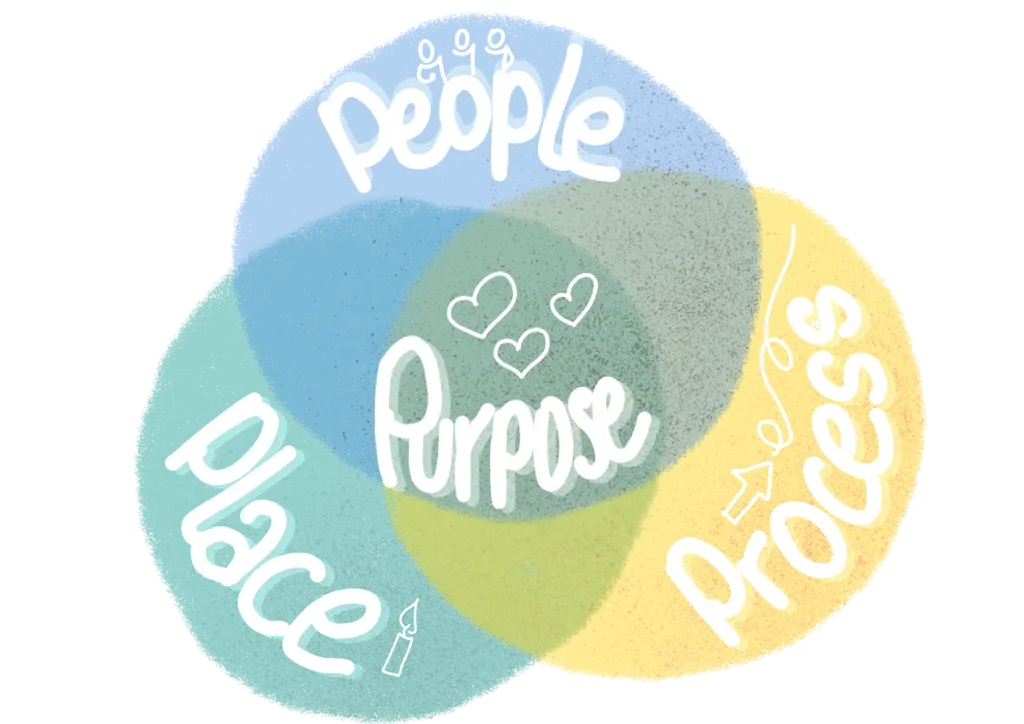When I try to solve a puzzle, I go through phases. I might start with the edge, then identify a few noticeable features, then sort pieces by type, going bit by bit – until finally there’s only a few less obvious pieces left and everything falls into place.
Preparing a meeting is a bit like that. There are a lot of disconnected pieces, and attempting to move all at once can feel overwhelming – so it’s a good idea to iterate during the preparation. You can start with the frame, fill in some features – and then work through the details.
For any meeting preparation, you’ll want to think through the four P’s: Purpose, People, Place and Process.

Set up a new document to capture these for your meeting – even if it’s just for yourself.
Start here: Purpose
Be it for connection, learning or co-creation: Every meeting has a purpose.
Questions you might want to ask:
- Occasion | Why are you organising the meeting? Is this the first meeting of its kind or are we building on something?
- Purpose | What is the general intention here? Why is this meeting important?
- Outcomes | What would you like to see, feel, do as a result of the meeting? What will have changed?
A summary of the above is a good foundation for the meeting invitation so that participants know what to expect.
People
People are at the core of every meeting. You might already have a fixed group of participants – or you might work with targeted invitations. In other cases, you might share an open invitation.
Questions you might want to ask:
- Composition | What kinds of people are participating? How many do we expect? Are they taking different roles?
- List | Is there already a list of participants? If not: By when do we want to have it – and how will we invite people?
- Preparation | What has been participants’ prior engagement in the issue? How do we want to engage and prepare with them before the meeting?
Place
Every meeting happens somewhere, be it at a specific location or online (or both!). I like to review the details in relation to the overall timeframe we’re working with.
Questions you might want to ask:
- Rooms | How many rooms will we have available for the meeting? What size are they? Do you have a floor plan? (Online: what technology are we using?)
- Nourishment | Will food and drinks be provided? If yes: when and where? How flexible are the break times? (Online: What do we need to consider regarding time zones?)
- Times | When does the meeting start and end? Is there additional programme for participants outside the meeting?
- Material | What material do we have available on-site (flipcharts, projector…)? What do we need to bring?
Process
Once you have an idea of people and place, you can think through the process – for the meeting itself, but also for the preparation and follow-up.
Questions you might want to ask:
- Team | Who is helping to organise the meeting? What are there roles? Will there be (external) speakers?
- Timeline | What are important moments between now and the meeting? What’s the timeline for preparation?
- Agenda | What items need to be on the agenda? What are the specific objectives for each step? What ideas are there for the methodology?
- Harvest | How will the meeting be documented? What are the next processes the results will feed into?
As with any good puzzle, you won’t have all answers at the beginning. Instead, you might slowly discover and develop them as you go. If you are working with a facilitator, they will help you think through the different pieces as part of the preparation process. If not, you can also do this on your own.
You can find a version of this list in my Facilitation Intake Form (docx).
I hope these questions help you with your next meeting!

